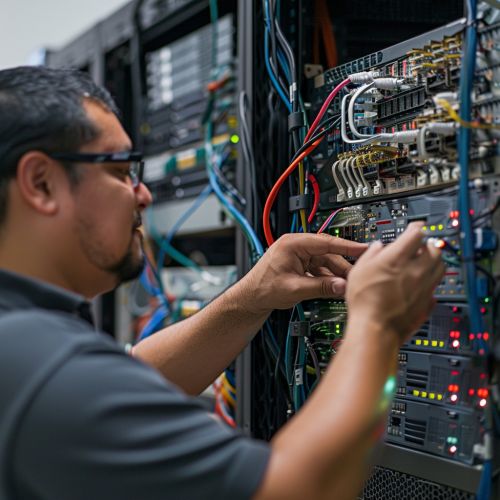Network Administration
Introduction
Network administration is a critical aspect of information technology that involves managing, maintaining, and securing computer networks. Network administrators are responsible for ensuring the smooth operation of network systems, which include local area networks (LANs), wide area networks (WANs), and other data communication systems. This article delves into the various facets of network administration, providing a comprehensive overview of the roles, responsibilities, tools, and technologies involved.
Roles and Responsibilities
Network administrators play a pivotal role in the IT infrastructure of an organization. Their primary responsibilities include:
- **Network Configuration**: Setting up and configuring network hardware and software, including routers, switches, firewalls, and network management tools.
- **Network Monitoring**: Continuously monitoring network performance to identify and resolve issues before they impact users.
- **Security Management**: Implementing and managing security measures to protect the network from unauthorized access, malware, and other threats.
- **Troubleshooting**: Diagnosing and resolving network problems, including connectivity issues, hardware failures, and software glitches.
- **User Support**: Assisting users with network-related issues and providing training on network usage and best practices.
- **Documentation**: Maintaining detailed records of network configurations, changes, and incidents to ensure continuity and compliance.
Network Configuration
Network configuration involves setting up network devices and software to ensure optimal performance and security. Key tasks include:
- **IP Address Management**: Assigning and managing IP addresses to devices within the network.
- **Routing and Switching**: Configuring routers and switches to direct data traffic efficiently.
- **Firewall Configuration**: Setting up firewalls to control incoming and outgoing network traffic based on predetermined security rules.
- **VPN Setup**: Establishing Virtual Private Networks (VPNs) to enable secure remote access to the network.


Network Monitoring
Effective network monitoring is essential for maintaining network health and performance. Network administrators use various tools and techniques to monitor network activity, including:
- **Network Performance Monitoring (NPM)**: Tools like SolarWinds NPM and Nagios help track network performance metrics such as bandwidth usage, latency, and packet loss.
- **Intrusion Detection Systems (IDS)**: Systems like Snort and Suricata monitor network traffic for suspicious activity and potential threats.
- **Log Management**: Collecting and analyzing logs from network devices to identify patterns and anomalies.
Security Management
Network security is a top priority for network administrators. Key security management tasks include:
- **Access Control**: Implementing policies and technologies to control who can access the network and what resources they can use.
- **Encryption**: Using encryption protocols like SSL and TLS to protect data in transit.
- **Patch Management**: Regularly updating network devices and software to address security vulnerabilities.
- **Incident Response**: Developing and executing plans to respond to security incidents, including data breaches and cyberattacks.
Troubleshooting
Network troubleshooting involves identifying and resolving issues that affect network performance and availability. Common troubleshooting tasks include:
- **Connectivity Issues**: Diagnosing and fixing problems that prevent devices from connecting to the network.
- **Hardware Failures**: Identifying and replacing faulty network hardware components.
- **Software Glitches**: Resolving issues with network software, such as misconfigurations or bugs.
- **Performance Bottlenecks**: Identifying and addressing factors that slow down network performance.
User Support
Providing support to network users is a crucial aspect of network administration. This includes:
- **Help Desk Support**: Assisting users with network-related issues, such as connectivity problems and access requests.
- **Training**: Educating users on network usage, security best practices, and troubleshooting techniques.
- **Documentation**: Creating and maintaining user guides, FAQs, and other resources to help users navigate the network.
Documentation
Maintaining accurate and up-to-date documentation is essential for network administration. Key documentation tasks include:
- **Network Diagrams**: Creating visual representations of the network architecture, including device locations and connections.
- **Configuration Records**: Keeping detailed records of network device configurations, including IP addresses, routing tables, and firewall rules.
- **Change Logs**: Documenting changes to the network, such as hardware upgrades, software updates, and configuration modifications.
- **Incident Reports**: Recording details of network incidents, including the cause, impact, and resolution.
Tools and Technologies
Network administrators rely on a variety of tools and technologies to manage and maintain networks. Some of the most commonly used tools include:
- **Network Management Software**: Tools like Cisco Prime and HP OpenView provide comprehensive network management capabilities.
- **Monitoring Tools**: Solutions like Wireshark and PRTG help monitor network traffic and performance.
- **Security Tools**: Applications like Nmap and Kali Linux assist with network security assessments and penetration testing.
- **Automation Tools**: Scripts and tools like Ansible and Puppet automate network configuration and management tasks.
Emerging Trends
The field of network administration is constantly evolving, with new trends and technologies shaping the landscape. Some emerging trends include:
- **Software-Defined Networking (SDN)**: SDN separates the control plane from the data plane, allowing for more flexible and programmable network management.
- **Network Function Virtualization (NFV)**: NFV replaces traditional network hardware with virtualized network functions, reducing costs and increasing scalability.
- **Cloud Networking**: The shift to cloud-based services and infrastructure is changing the way networks are designed and managed.
- **Artificial Intelligence (AI)**: AI and machine learning are being used to enhance network monitoring, security, and automation.
Conclusion
Network administration is a complex and dynamic field that requires a deep understanding of network technologies, security practices, and troubleshooting techniques. Network administrators play a vital role in ensuring the reliability, performance, and security of an organization's IT infrastructure. As technology continues to evolve, network administrators must stay abreast of emerging trends and continuously update their skills to meet the challenges of modern network management.
